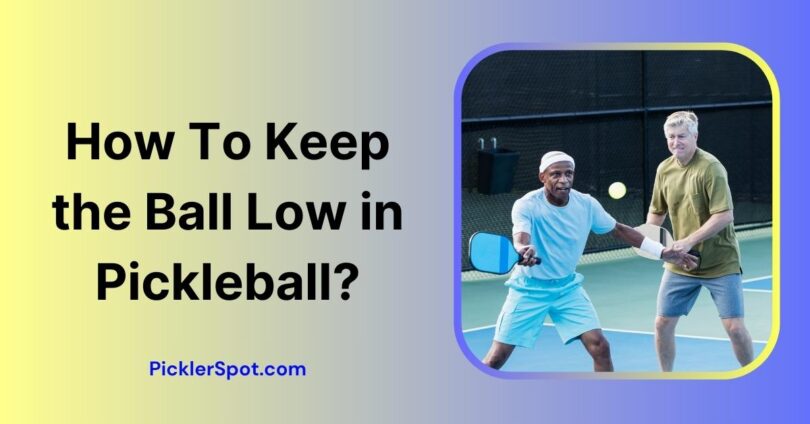Casual or competitive, regardless of the settings in which a session of Pickleball is conducted, it is certain both teams need to keep each other on their toes by executing various strategies and techniques.
One of the most effective strategies known amongst the Pickleball community is slicing the ball to ensure its trajectory is kept as low as possible which puts the opponent in a rough spot, if you are interested in How to keep the ball low in pickleball, follow the tips and tricks I will be mentioning below so that you could also replicate it and secure yourself a couple of victories right of the bat.
Understanding The Basics of Ball Trajectory
The trajectory point of a ball initiates when it touches the surface of the paddle and ends when it makes its way across the net. The point of the trajectory can be manipulated via,
Face Of The Paddle
Make sure the face of the paddle is oriented towards the ground while executing a shot so that it doesn’t produce a higher curvature, resulting in a lower initial trajectory point.
This is a surefire method to ensure the ball will remain low when it bounces off the surface since it barely has the time to build momentum to bounce higher.
Anti-Sweet Spot
A Paddle in Pickleball generally has two spots, one that favors and provides a critical hit and is known as the Sweet spot while the other does the exact opposite and is usually located right at the lower edge of the paddle.
Hitting the ball while orienting the paddle on this spot certainly works wonders even if you accidentally the ball with considerable force because most of the shock waves of the ball are dampened to a great degree, as compared to a sweet spot which barely absorbs the energy of the ball while repelling it with full force.
Flick Speed
Lastly, if you use minimal force, it is apparent that you will achieve a lower trajectory point as the force of your wrist directly correlates to the path of the trajectory of the ball, so the higher the force, the straighter the route it will follow without getting affected by the forces of gravity.
How To Keep The Ball Low In Pickleball?
Understanding the above information is extremely crucial if you want to ensure the ball bounce frequency is as low as possible, however, to maximize the effect, here are some techniques you can perform.
Underhand Dinks
Dinks are the holy grail of Pickleball especially if you execute it right across the net while performing an underhand shot, the lower orientation of the face of the paddle compliments the minimal force Dink and produces outstanding results.
However, the catch here is that you need to ensure your timing is perfect to put your opponent in a rough spot.
An Underhand Dink is considered perfect if you apply variation so that your opponent has minimal chances to repel the ball in time, otherwise, no matter how low the ball seems, without properly planning out the timing all your efforts are pretty much in vain.
Use Continental Grip
This is by far one of the most effective approaches to ensure the ball always remains low especially if you are closer to the net.
On the other hand, it also helps those individuals who are struggling with performing an underhand dink, since this grip will strengthen your transition from underhand to forehand oriration seamlessly.
All you have to do is hold the paddle similar to performing a handshake while keeping your index finger perpendicular to the grip. The sides of the paddle have to be facing the surface of the court when using the Continental grip so you can easily find the right balance between the speed and force of your shot.
Meanwhile, you can also integrate a topspin so that the ball lands low when it crosses the net, since spinning the ball changes the dynamics and how it will land on the ball, and as top spins are designed to reduce the “forward energy” it holds, the ball won’t bounce higher.
Why Is My Ball Still Higher Than It Is Supposed To Be?
If you feel like you are doing everything that is mentioned above and still fail to keep your ball low in Pickleball, you might be repeating rookie mistakes such as,
- Improperly Aligning the Face of Your Pickleball Paddle, resulting in poor trajectory.
- Using Too Much Force even if you are using topspin.
- Failure to perform proper spinning action due to equipment issues or lack of texture on the Paddle.
- Lack Of Consistency in your shots as the ball may not hit the lower edge of your Paddle altogether.
How Should I Build Consistency To Keep The Ball Low?
Pickleball is all about having consistency which is only possible if you have built muscle memory after performing countless drills alone on the court. Practice makes perfect and the only way to effectively perform Understroke Dinks or hit the ball at the correct spot on your Paddle is by practicing your serves alone or with your partner.
Fortunately for you, it only takes around a week or so in order to have enough hand-eye coordination and muscle memory to know where you should hit the ball with enough force for it to have little to no bounce back.
As an added bonus, if you really want to raise the bar of your skillsets, you need to memorize the travel time of the trajectory of your ball and calculate it by the surface area of the Kitchen zone.
A non volley zone or Kitchen region is approximately 7 feet across the net, so make sure you hit the ball right at the edge, to minimize the chances of response of your opponent altogether.
And That’s a Wrap
One of the most prominent signs of proficient players in Pickleabll court is unpredictability and how they build rhythms that couldn’t be tracked even by the most renowned players. Keeping the ball low in the court is an amazing tactic to confuse your opponent, however, make sure you use moderation and only execute it when they are expecting the least.
If you are struggling with building a proper rhythm or have a hard time being discrete with your shots, try to implement variations such as imparting a slice shot by either using back or topspin to make the ball move in unexpected directions.
However, all of these are only possible if you have dexterity which is only gained through sheer focus and practice by spending time in court.









